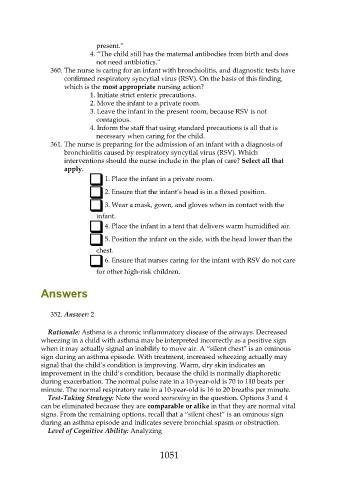Page 1051 - Saunders Comprehensive Review For NCLEX-RN
P. 1051
present.”
4. “The child still has the maternal antibodies from birth and does
not need antibiotics.”
360. The nurse is caring for an infant with bronchiolitis, and diagnostic tests have
confirmed respiratory syncytial virus (RSV). On the basis of this finding,
which is the most appropriate nursing action?
1. Initiate strict enteric precautions.
2. Move the infant to a private room.
3. Leave the infant in the present room, because RSV is not
contagious.
4. Inform the staff that using standard precautions is all that is
necessary when caring for the child.
361. The nurse is preparing for the admission of an infant with a diagnosis of
bronchiolitis caused by respiratory syncytial virus (RSV). Which
interventions should the nurse include in the plan of care? Select all that
apply.
1. Place the infant in a private room.
2. Ensure that the infant’s head is in a flexed position.
3. Wear a mask, gown, and gloves when in contact with the
infant.
4. Place the infant in a tent that delivers warm humidified air.
5. Position the infant on the side, with the head lower than the
chest.
6. Ensure that nurses caring for the infant with RSV do not care
for other high-risk children.
Answers
352. Answer: 2
Rationale: Asthma is a chronic inflammatory disease of the airways. Decreased
wheezing in a child with asthma may be interpreted incorrectly as a positive sign
when it may actually signal an inability to move air. A “silent chest” is an ominous
sign during an asthma episode. With treatment, increased wheezing actually may
signal that the child’s condition is improving. Warm, dry skin indicates an
improvement in the child’s condition, because the child is normally diaphoretic
during exacerbation. The normal pulse rate in a 10-year-old is 70 to 110 beats per
minute. The normal respiratory rate in a 10-year-old is 16 to 20 breaths per minute.
Test-Taking Strategy: Note the word worsening in the question. Options 3 and 4
can be eliminated because they are comparable or alike in that they are normal vital
signs. From the remaining options, recall that a “silent chest” is an ominous sign
during an asthma episode and indicates severe bronchial spasm or obstruction.
Level of Cognitive Ability: Analyzing
1051

